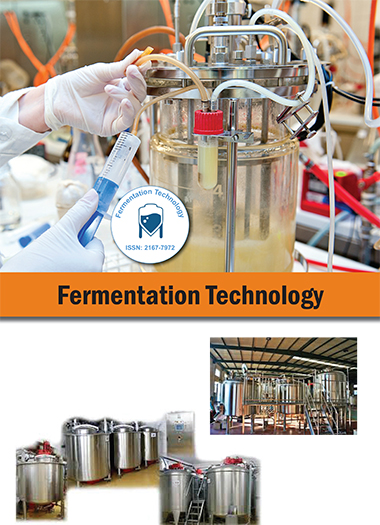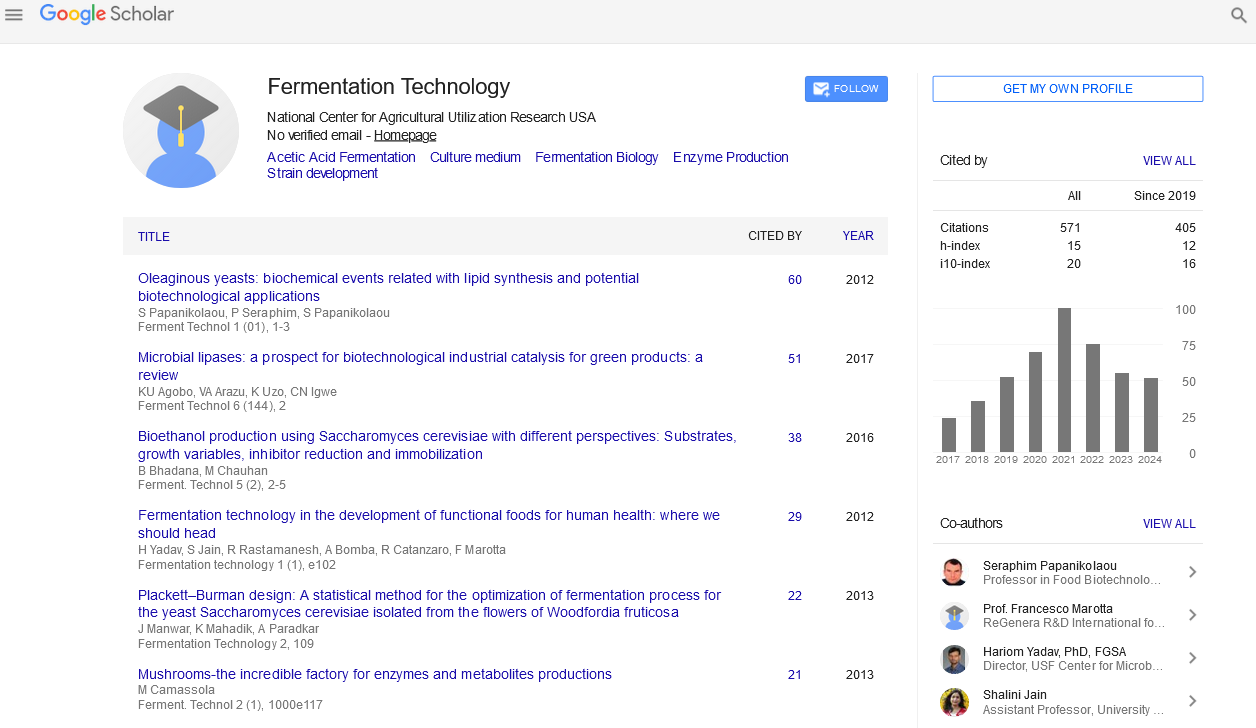Indexed In
- Open J Gate
- Genamics JournalSeek
- Access to Global Online Research in Agriculture (AGORA)
- RefSeek
- Hamdard University
- EBSCO A-Z
- OCLC- WorldCat
- Publons
Useful Links
Share This Page
Journal Flyer

Open Access Journals
- Agri and Aquaculture
- Biochemistry
- Bioinformatics & Systems Biology
- Business & Management
- Chemistry
- Clinical Sciences
- Engineering
- Food & Nutrition
- General Science
- Genetics & Molecular Biology
- Immunology & Microbiology
- Medical Sciences
- Neuroscience & Psychology
- Nursing & Health Care
- Pharmaceutical Sciences
Perspective - (2022) Volume 11, Issue 1
Microbial Electrostatic Interactions Accelerated Fermentation to Improve Ethanol Production
Finn David*Received: 07-Nov-2022, Manuscript No. FMT-22-18923; Editor assigned: 09-Nov-2022, Pre QC No. FMT-22-18923 (PQ); Reviewed: 25-Nov-2022, QC No. FMT-22-18923; Revised: 01-Dec-2022, Manuscript No. FMT-22-18923 (R); Published: 08-Dec-2022, DOI: 10.4172/2167-7972.22.11.153
Description
This use of ethanol as an alternative fuel is growing on a global scale. The ethanol sector is thought to benefit from improvement in every component of ethanol production. The highest ethanol concentration of 8% can be produced by traditional fermentation in 50 to 70 hours. a process that uses electrostatic fermentation to speed up the fermenting of glucose with Saccharomyces cerevisiae acting as the primary ethanol- producing microbe. The fermentation nearly completely consumes the glucose. The ethanol production can reach 14% using pre-cultured yeast in 20 hours. With a 2 liter fermenting mixture, the method's ability to scale up is proved. Due to the electrostatic nature of the process, no outside energy is required. There has been a lot of interest in ethanol as an environmentally friendly and renewable fuel1. The rapid depletion of the world's oil reserves and the deteriorating environmental conditions are the main causes of the sharp increase. Traditionally, the fermenting of sugar employing cultivated Saccharomyces cerevisiae, also known as baker's yeast, as the fermentation microbe results in the industrial manufacture of ethanol for use as fuel.
The specific strains or microorganisms can withstand higher ethanol concentrations because they have lower ethanol stress thresholds. With an initial glucose concentration of more than 250, it has been demonstrated that these particular fermenting bacteria can even produce ethanol levels at the 15% level. Zymomonas mobilis and S. cerevisiae have been used to demonstrate this extremely high gravity fermentation. The most beneficial yeasts for this process are those with high tolerances to ethanol and salt. Additionally, yeasts must be able to use both glucose and pentose like xylose and arabinose in order to successfully create ethanol from lignocelluloses’ hydro lysates. This is due to the high glucose and xylose content in lignocelluloses’ biomass. Because S. cerevisiae cannot ferment either glucose or xylose, this is the fundamental disadvantage of employing it alone. Therefore, finding strains were isolated that can ferment either glucose and xylose is essential; if not, employ two different yeast strains that can utilize these sugars separately. Electro-fermentation technology, which combines electrochemistry with conventional fermentation, can be used to increase ethanol production. In a revolutionary method called electro-fermentation, the bacterial fermentative metabolism can be electrochemically controlled. The electrodes of the electrochemical cell can operate as electron sources, sinks, or polarize ions in the microorganisms to promote an imbalanced growth. These electrochemical alterations also have a substantial impact on interspecies relationships, microbial population selection, metabolism and cellular control. The yeast strains were cultivated in anodic and cathode chambers for the initial fermentation process, respectively. The yeast strains were cultivated inside anodic and cathode chambers, respectively, in a second fermentation reaction. By cultivating S. cerevisiae strains from various sources, ethanol production in the anodic compartment was observed in order to compare the efficiency of S. cerevisiae in producing ethanol.
To create ethanol, lignocellulose biomass hydro lysate was further fermented with media additions. In chambers, the hydro lysates were stored. Following autoclaving, the anodic and cathode chambers were inoculated with and yeast strains, respectively. A nafion membrane divided the two compartments. Utilizing optical density measurements from a spectrophotometer, the growth of the yeast was studied in order to shed light on the reason behind the considerable increase in ethanol yield. Without any pre-culture, fermentation was initiated with dry S. cerevisiae. It can take up to several hours for dry yeast to fully recover from the preparation for reproduction that occurs during the lag phase of yeast budding. Demonstrates the observed yeast concentration profiles for two growth processes, half-strength MS medium supplemented with sucrose was incubated for 12 hours with plant tissues grown in vitro to maintain ethanol yield when subjected to the aerobic or hypoxic treatment. Both the ethanol and the leftover liquid medium were collected. The preservation of fermentation process among terrestrial plants implies the necessity of this pathway to deal with respiratory restriction during an aerobic condition, regardless of how it is regulated. In fact, reduction to ethanol helps to regenerate NAD+, which supports glycolytic fluxes. ADH activity may also aid in reducing hazardous acetaldehyde pools that accumulate after pyruvate decarboxylation. Because the cathode was the electrophile and caused more NAD+ to beconverted to NADH, which in turn caused more pyruvate to be converted to ethanol, there was an increase in ethanol production when the yeast strain was cultivated in the cathode compartment.
Citation: David F (2022) Microbial Electrostatic Interactions Accelerated Fermentation to Improve Ethanol Production. Ferment Technol. 11:153.
Copyright: © 2022 David F. This is an open-access article distributed under the terms of the Creative Commons Attribution License, which permits unrestricted use, distribution, and reproduction in any medium, provided the original author and source are credited.

